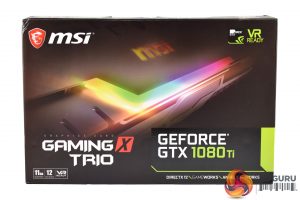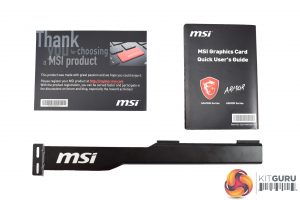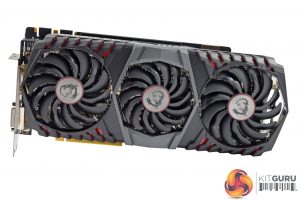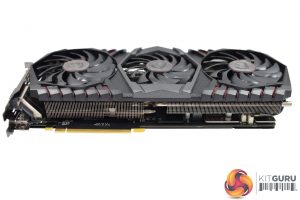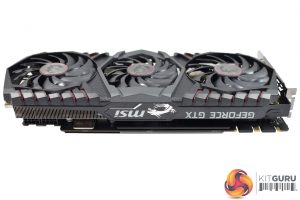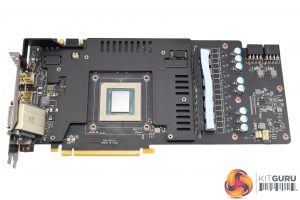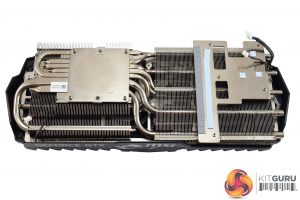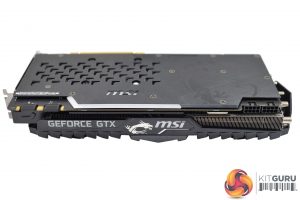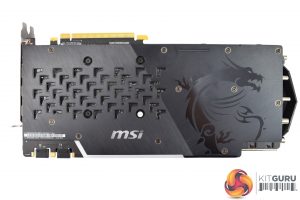The MSI GTX 1080 Ti Gaming X Trio ships in a dark box, though there is a very bright and colourful photo of the card's RGB strip on the front.
Inside, we get the usual thank you card, as well as a quick-start guide. However, more interesting is the metal support bracket that comes included. This is designed to prevent the dreaded ‘GPU sag' which is common among big-and-heavy graphics cards. There are third-party solutions on the market, but it is good to see MSI include something in the box.
Moving on to the card itself, it is clearly quite large. It measures 325 x 140 x 48 mm, weighs over 1.4KG and is a two-and-a-half slot card as well.
The reason for the card's heft is the beefy cooler – essentially the same as the Lightning model, it sports 3x Torx 2.0 fans (the outer two measure 100mm, while the central fan measures 92mm) as well as 6 heatpipes (2x 8mm, 4x 6mm).
The overall look of the cooler, though, is more in-line with the Gaming X series. This means the shroud is a combination of black and gunmetal grey plastic, while there are still some red-only LEDs on the shroud which have proved quite divisive in the past. There is definitely less red on the card than the standard Gaming X model, but the Gaming X Trio is still not completely colour neutral.
Visible from each side of the card is the mammoth heatsink and fin array – see below for a ‘naked' shot, but it is clear that this cooler is not small.
To get a proper look at the cooler, we prised the heatsink away from the PCB by removing the backplate and then the four GPU screws.
Starting with the PCB, it is clearly an aftermarket design – from the looks of it, it is essentially a GTX 1080 Ti Gaming X PCB. The most visible addition is MSI's use of a contact plate on the VRAM chips that surround the GPU core.
The cooler itself uses nickel-plated copper for the contact area and the heatpipes – whether this provides tangible cooling benefits is unclear, but is definitely looks better than raw copper tubing.
Elsewhere, on the front side of the card (speaking as if a user was looking at the card installed in a PC) we find the MSI dragon logo and branding. Above this we see a slim LED strip which is RGB-capable via MSI Mystic Light. The MSI branding and dragon logo, however, are not illuminated.
The card's backplate is very tasteful, with a brushed-metal finish and a monochrome look. The MSI dragon is also present, but blends in very well and does not look tacky at all.
Unsurprisingly, the Gaming X Trio requires 2x 8-pin PCIe power connectors, while MSI touts its power consumption at 250W.
Lastly, the I/O is worth touching upon. MSI went with 2x HDMI 2.0 ports, 2x DisplayPort 1.4 and 1x DVI-D port. This is obviously one extra HDMI over the standard configuration, and one would assume this has been done to accommodate the rise of VR headsets.
 KitGuru KitGuru.net – Tech News | Hardware News | Hardware Reviews | IOS | Mobile | Gaming | Graphics Cards
KitGuru KitGuru.net – Tech News | Hardware News | Hardware Reviews | IOS | Mobile | Gaming | Graphics Cards


